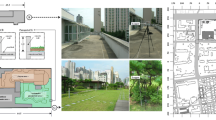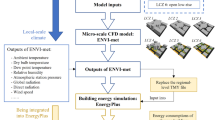Abstract
A passive means of lowering the energy demand of buildings is the application of green roofs. The complexity between heat and moisture exchanges in green roof layers and the large variations of green roof types make the need for experimental or simulation assessments necessary for quantifying the energy benefits from green roofs. The current treatment of green roofs in simulation programs is either over-simplistic, for example by ignoring heat and moisture exchanges such as evapotranspiration, or the more advanced models have limitations and require inputs that are rarely available in practice. In this paper a combination of experimental and modelling techniques are used to assess the potential heating and cooling load reductions from the application of green roofs in the subtropical climate of Ningbo in China. The method provides a generalised energy performance assessment of green roofs in Ningbo by overcoming the limitations of existing green roof simulation models.
Similar content being viewed by others
References
Alexandri E, Jones P (2008). Temperature decreases in an urban canyon due to green walls and green roofs in diverse climates. Building and Environment, 43: 480–493.
Banting D, Doshi H, Li J, Missios P, Au A, Currie BA, Verrati M (2005). Report on the Environmental Benefits and Costs of Green Roof Technology for the City of Toronto. Report prepared for City of Toronto and Ontario Centres of Excellence — Earth and Environmental Technologies (OCE-ETech) by Ryerson University. Available: http://www.toronto.ca/greenroofs/pdf/fullreport103105.pdf. Accessed Jan. 1 2013.
Brenneisen S (2003). The benefits of biodiversity from green roofs — Key design consequences. In: Proceedings of 1st North American Greenroof Conference: Greening Rooftops for Sustainable Communities, Chicago, USA, pp. 323–329.
Castleton HF, Stovin V, Beck SBM, Davison JB (2010). Green roofs; building energy savings and the potential for retrofit. Energy and Buildings, 42: 1582–1591.
Feng C, Meng Q, Zhang Y (2010). Theoretical and experimental analysis of the energy balance of extensive green roofs. Energy and Buildings, 42: 959–965.
Jaffal I, Ouldboukhitine S-E, Belarbi R (2012). A comprehensive study of the impact of green roofs on building energy performance. Renewable Energy, 43: 157–164.
Jim CY, Tsang SW (2011). Biophysical properties and thermal performance of an intensive green roof. Building and Environment, 46: 1263–1274.
IEA (2012). CO2 emissions from fuel combustion highlights. International Energy Agency (IEA) Statistics, 2012 edition.
Kelly NJ (1998). Towards a design environment for building-integrated energy systems: The integration of electrical power flow modeling with building simulation. PhD Thesis, University of Strathclyde, UK.
Mentens J, Raes D, Hermy M (2006). Green roofs as a tool for solving the rainwater runoff problem in the urbanized 21st century? Landscape and Urban Planning, 77: 217–226.
Onmura S, Matsumoto M, Hokoi S (2001). Study on evaporative cooling effect of roof lawn gardens. Energy and Buildings, 33: 653–666.
Palomo DBE (1998). Analysis of the green roofs cooling potential in buildings. Energy and Buildings, 27: 179–193.
Sailor DJ (2008). A green roof model for building energy simulation programs. Energy and Buildings, 40: 1466–1478.
Strachan P, Kokogiannakis G, Macdonald I (2008). History and development of validation with the ESP-r simulation program. Building and Environment, 43: 601–609.
Susca T, Gaffin SR, Dell’Osso GR (2011). Positive effects of vegetation: Urban heat island and green roofs. Environmental Pollution, 159: 2119–2126.
Tabares-Velasco PC, Srebric J (2012). A heat transfer model for assessment of plant based roofing systems in summer conditions. Building and Environment, 49: 310–323.
Teemusk A, Mander U (2007). Rainwater runoff quantity and quality performance from a green roof: the effects of short-term events. Ecological Engineering, 30: 271–277.
Wong NH, Chen Y, Ong CL, Sia A (2003). Investigation of thermal benefits of rooftop garden in the tropical environment. Building and Environment, 38: 261–270.
Yang J, Yu Q, Gong P (2008). Quantifying air pollution removal by green roofs in Chicago. Atmospheric Environment, 42: 7266–7273.
Author information
Authors and Affiliations
Corresponding author
Rights and permissions
About this article
Cite this article
Kokogiannakis, G., Darkwa, J. & Yuan, K. A combined experimental and simulation method for appraising the energy performance of green roofs in Ningbo’s Chinese climate. Build. Simul. 7, 13–20 (2014). https://doi.org/10.1007/s12273-013-0149-0
Received:
Revised:
Accepted:
Published:
Issue Date:
DOI: https://doi.org/10.1007/s12273-013-0149-0




